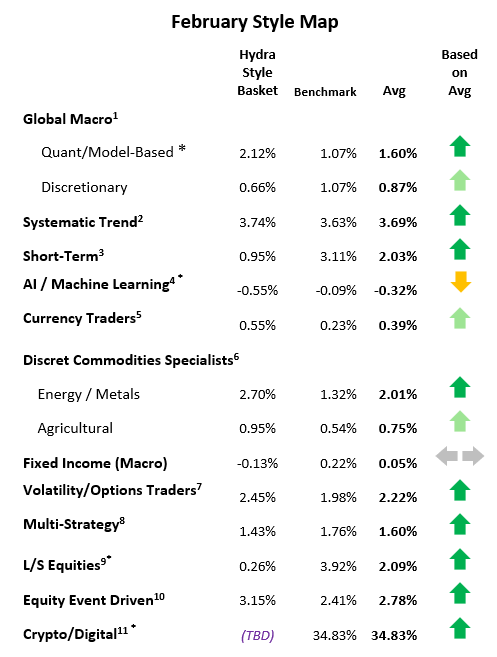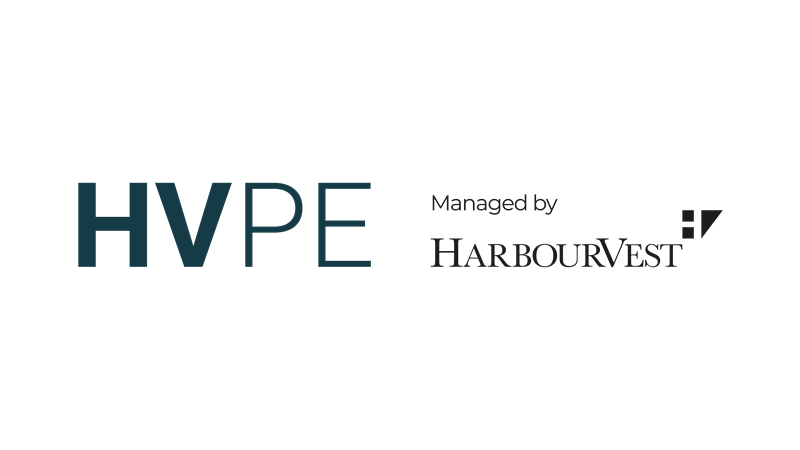Kettera Strategies Heat Map - February 2021
For most model-driven global macro programs, the breakdown of returns by market sector largely mirrored that of the systematic trend followers – although the entry and exit points were quite different. The commodities sector, primarily industrial metals and energies, seems to have become the dominant force in this style category. (It also led the way in December but was the biggest detractor in January.) This sector led the charge again in February. We note that those programs with RV / spread positions in energies appeared to fare better than directional energy trades.
February offered investors one of the best months in years for Systematic Trend. Since the start of this year, most trend followers have climbed on board four strong Covid recovery trends: long G10 equities, long commodities, short Dollar and short US fixed income. In February, long commodities was the dominant theme. It’s been hard to find a systematic trend program that was positive that did not have a heavy focus in long commodities.
Short Term strategies were, as always, somewhat of a mixed bag in February, but positive overall, as several key markets experienced volatility breakouts, which are good for short-term strategies. Those nimble enough to short rates and bonds, especially in the last week of the month, booked outsized returns. Several programs captured the upwards moves in metals, especially base metals like copper, long crude and long equities. Some others were even quick enough to capture the selloff in equities in the last days of the month. The currency markets in February, in contrast, did not seem to lend themselves well to these types of strategies.
Commodities markets generally had another strong upwards push in February, with energy and base metals strategies outperforming agricultural programs. Energy traders performed well, especially those with long exposures to crude and refined products markets. Nat Gas traders had a trickier time dealing with choppiness, but also performed well. Many metals traders also capitalized on the month, especially those that were long industrial metals markets like copper. Precious metals have been weak so far this year, and traders have reduced exposures.
Event driven managers, which includes merger arbitrage strategies, had an outsized month. Most programs we follow capitalized on deal flow in the technology, financials, and health care sectors. As SPACs continue to gain in popularity, this sector also was the source of strong contributions among event-driven programs. The volume of SPAC issuance is quite high and many deal announcements have resulted in sharp price increases.

**********
For the “style classes” and “baskets” presented in this letter: The “style baskets” referenced above were created by Kettera for research purposes to track the category and are classifications drawn by Kettera Strategies in their review of programs on and for the Hydra Platform. The arrows represent the style basket’s overall performance for the month (e.g. the sideways arrow indicates that the basket was largely flat overall, a solid red down arrow indicates the basket (on average) was largely negative compared to most months, etc.). The “style basket” for a class is created from monthly returns (net of fees) of programs that are either: programs currently or formerly on Hydra; or under review with an expectation of being added to Hydra. The weighting of a program in a basket depends upon into which of these three groups the program falls. Style baskets are not investible products or index products being offered to investors. They are meant purely for analysis and comparison purposes. These also were not created to stimulate interest in any underlying or associated program. Nonetheless, as these research tools may be regarded to be “hypothetical” combinations of managers, hypothetical performance results have many inherent limitations, some of which are described below. No representation is being made that any product or account will achieve profits or losses similar to those shown. In fact, there are frequently sharp differences between hypothetical performance results and the actual results subsequently achieved by any particular trading program. One of the limitations of hypothetical results is that they are generally prepared with the benefit of hindsight. In addition, hypothetical trading does not involve financial risk, and no hypothetical trading record can completely account for the impact of financial risk in actual trading. There are numerous other factors related to the markets in general or to the implementation of any specific trading program which cannot be fully accounted for in the preparation of hypothetical performance results and all of which can adversely affect actual trading results.
Benchmark sources:
1-The Hedge Fund Intelligence Global Macro Index and HFI Currency Index
2-The Societe Generale Trend Index and SG CTA Index
3-The Societe General Short-term Traders Index: (same link as above)
4-The Eurekahedge AI Hedge Fund Index
5-The BarclayHedge Currency Traders Index and BTOP FX Traders Index
6- S&P GSCI Metals & Energy Index and S&P GSCI Ag Commodities Index
7-The CBOE Eurekahedge Relative Value Volatility Hedge Fund Index
8-The Eurekahedge-Mizuho Multi-Strategy Index: (See above)
9-The Eurekahedge Long Short Equities Hedge Fund Index: (See above)
10-Blend of BarclayHedge Equity Market Neutral Index with Eurekahedge Equity Mkt Neutral Index (see link above)
11 – Barclay Crypto Traders Index.
Indices and other financial benchmarks shown are provided for illustrative purposes only, are unmanaged, reflect reinvestment of income and dividends and do not reflect the impact of advisory fees. Index data is reported as of date of publication and may be a month-to-date estimate if all underlying components have not yet reported. The index providers may update their reported performance from time to time. Kettera disclaims any obligation to verify these numbers or to update or revise the performance numbers.
***
The views expressed in this article are those of the author and do not necessarily reflect the views of AlphaWeek or its publisher, The Sortino Group
© The Sortino Group Ltd
All Rights Reserved. No part of this publication may be reproduced, stored in a retrieval system or transmitted in any form or by any means, electronic, mechanical, photocopying, recording or scanning or otherwise, except under the terms of the Copyright, Designs and Patents Act 1988 or under the terms of a licence issued by the Copyright Licensing Agency or other Reprographic Rights Organisation, without the written permission of the publisher. For more information about reprints from AlphaWeek, click here.







